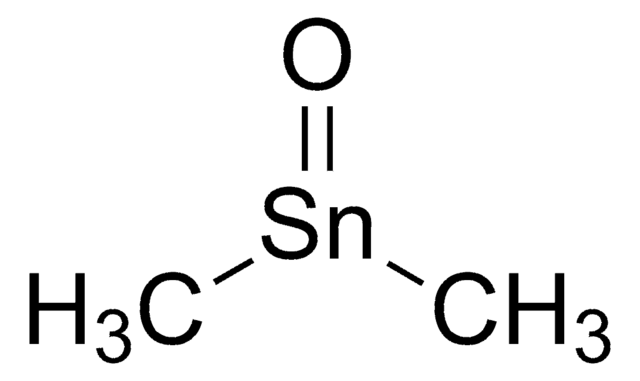290890
Dibutyltin diacetate
technical grade
Synonym(s):
Diacetoxydibutyltin
About This Item
Recommended Products
grade
technical grade
vapor density
12 (vs air)
vapor pressure
1.3 mmHg ( 25 °C)
refractive index
n20/D 1.471 (lit.)
bp
142-145 °C/10 mmHg (lit.)
mp
7-10 °C (lit.)
density
1.32 g/mL at 25 °C (lit.)
SMILES string
CCCC[Sn](CCCC)(OC(C)=O)OC(C)=O
InChI
1S/2C4H9.2C2H4O2.Sn/c2*1-3-4-2;2*1-2(3)4;/h2*1,3-4H2,2H3;2*1H3,(H,3,4);/q;;;;+2/p-2
InChI key
JJLKTTCRRLHVGL-UHFFFAOYSA-L
Looking for similar products? Visit Product Comparison Guide
Related Categories
General description
Application
- Wittenberger tetrazole derivatives by reacting with various nitriles in the presence of trimethylsilyl azide.
- Carbamate derivatives from various isocyanates and alcohols in the presence of dichloromethane as solvent.
- Urea derivatives from aryl isocyanates and various amines in the presence of 4-methylmorpholine.
Signal Word
Danger
Hazard Statements
Precautionary Statements
Hazard Classifications
Aquatic Acute 1 - Aquatic Chronic 1 - Eye Dam. 1 - Muta. 2 - Repr. 1B - Skin Corr. 1B - Skin Sens. 1 - STOT RE 1 - STOT SE 1 Oral
Target Organs
thymus gland, thymus gland,Immune system
Storage Class Code
6.1A - Combustible acute toxic Cat. 1 and 2 / very toxic hazardous materials
WGK
WGK 3
Flash Point(F)
302.9 °F - Pensky-Martens closed cup
Flash Point(C)
150.5 °C - Pensky-Martens closed cup
Personal Protective Equipment
Certificates of Analysis (COA)
Search for Certificates of Analysis (COA) by entering the products Lot/Batch Number. Lot and Batch Numbers can be found on a product’s label following the words ‘Lot’ or ‘Batch’.
Already Own This Product?
Find documentation for the products that you have recently purchased in the Document Library.
Customers Also Viewed
Our team of scientists has experience in all areas of research including Life Science, Material Science, Chemical Synthesis, Chromatography, Analytical and many others.
Contact Technical Service















